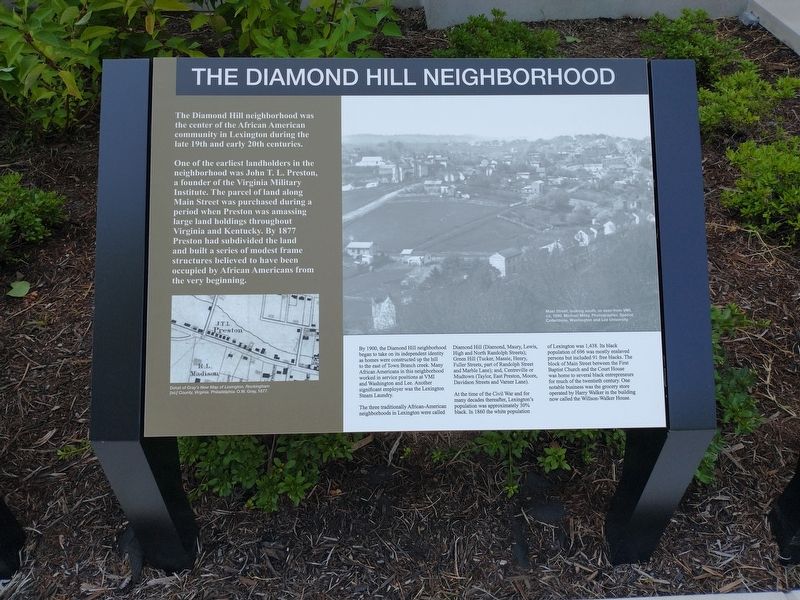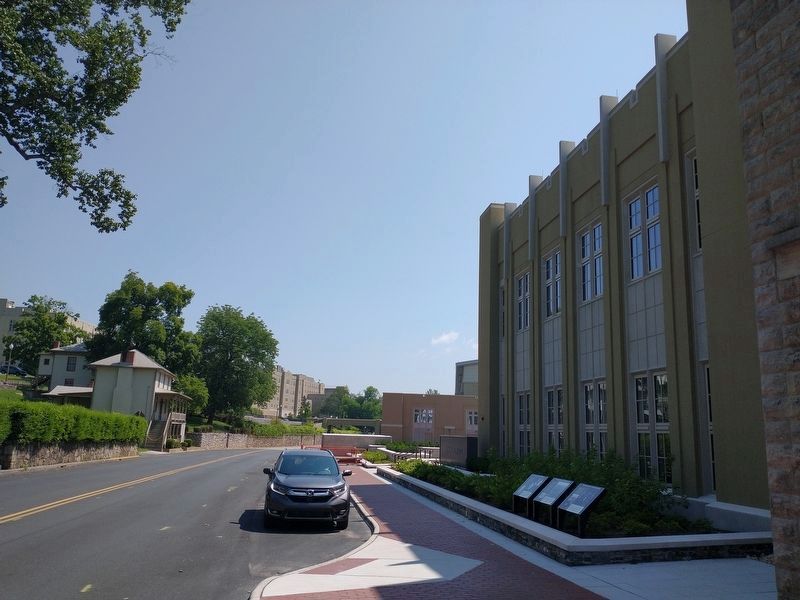Lexington, Virginia — The American South (Mid-Atlantic)
The Diamond Hill Neighborhood
The Diamond Hill neighborhood was the center of the African American community in Lexington during the late 19th and early 20th centuries. One of the earliest landholders in the neighborhood was John T. L. Preston, a founder of the Virginia Military Institute.
The parcel of land along Main Street was purchased during a period when Preston was amassing large land holdings throughout Virginia and Kentucky. By 1877 Preston had subdivided the land and built a series of modest frame structures believed to have been occupied by African Americans from the very beginning.
By 1900, the Diamond Hill neighborhood began to take on its independent identity as homes were constructed up the hill to the east of Town Branch creek. Many African Americans in this neighborhood worked in service positions at VMI and Washington and Lee. Another significant employer was the Lexington Steam Laundry.
The three traditionally African-American neighborhoods in Lexington were called Diamond Hill (Diamond, Maury, Lewis, High and North Randolph Streets); Green Hill (Tucker, Massie, Henry, Fuller Streets, part of Randolph Street and Marble Lane); and, Centreville or Mudtown (Taylor, East Preston, Moore, Davidson Streets and Varner Lane).
At the tie of the Civil War and for many decades thereafter, Lexington’s population was approximately 30% black. In 1860 the white population of Lexington was 1,438. Its black population of 696 was mostly enslaved persons but included 91 free blacks. The block of Main Street between the First Baptist Church and the Court House was home to several black entrepreneurs for much of the twentieth century. One notable business was the grocery store operated by Harry walker in the building now called the Willson-Walker House.
Topics. This historical marker is listed in these topic lists: African Americans • Settlements & Settlers. A significant historical year for this entry is 1877.
Location. 37° 47.29′ N, 79° 26.324′ W. Marker is in Lexington, Virginia. Marker is on North Main Street (Business U.S. 11) just north of Maiden Lane, on the right when traveling north. Touch for map. Marker is at or near this postal address: 311 N Main St, Lexington VA 24450, United States of America. Touch for directions.
Other nearby markers. At least 8 other markers are within walking distance of this marker. The Knights of Pythias Building (here, next to this marker); The Hall-Poindexter House (here, next to this marker); Virginia Military Institute (within shouting distance of this marker); Virginia Military Institute: A National Historic Landmark (about 400 feet away, measured in a direct line); The Cabell House (about 500 feet away); a different marker also named Virginia Military Institute
(about 500 feet away); Sigma Nu Fraternity (about 600 feet away); Hotchkiss House (about 600 feet away). Touch for a list and map of all markers in Lexington.
Related markers. Click here for a list of markers that are related to this marker.
Credits. This page was last revised on August 20, 2023. It was originally submitted on August 20, 2023, by Tom Bosse of Jefferson City, Tennessee. This page has been viewed 204 times since then and 135 times this year. Photos: 1, 2. submitted on August 20, 2023, by Tom Bosse of Jefferson City, Tennessee. • Devry Becker Jones was the editor who published this page.

